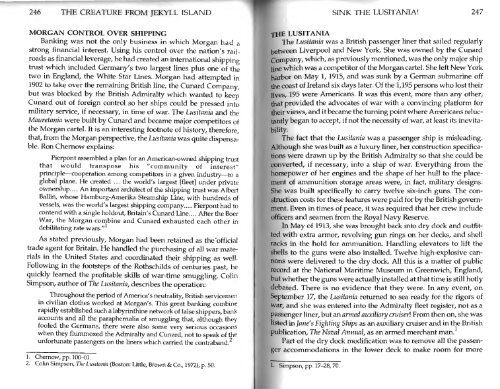You also want an ePaper? Increase the reach of your titles
YUMPU automatically turns print PDFs into web optimized ePapers that Google loves.
246 THE CREATURE FROM JEKYLL ISLAND SINK THE LUSITANIA! 247<br />
MORGAN CONTROL OVER SHIPPING<br />
Banking was not the only business in which Morgan had a<br />
strong financial interest. Using his control over the nation's railroads<br />
as financial leverage, he had created an international shipping<br />
trust which included Germany's two largest lines plus one of the<br />
two in England, the White Star Lines. Morgan had attempted in<br />
1902 to take over the remaining British line, the Cunard Company,<br />
but was blocked by the British Admiralty which wanted to keep<br />
Cunard out of foreign control so her ships could be pressed into<br />
military service, if necessary, in time of war. The Lusitania and the<br />
Mauretania were built by Cunard and became major competitors of<br />
the Morgan cartel. It is an interesting footnote of history, therefore,<br />
that, from the Morgan perspective, the Lusitania was quite dispensable.<br />
Ron Chernow explains:<br />
Pierpont assembled a plan for an American-owned shipping trust<br />
that would transpose his "community of interest"<br />
principle—cooperation among competitors in a given industry—to a<br />
global plane. He created ... the world's largest [fleet] under private<br />
ownership.... An important architect of the shipping trust was Albert<br />
Ballin, whose Hamburg-Amerika Steamship Line, with hundreds of<br />
vessels, was the world's largest shipping company.... Pierpont had to<br />
contend with a single holdout, Britain's Cunard Line.. . . After the Boer<br />
War, the Morgan combine and Cunard exhausted each other in<br />
debilitating rate wars." 1<br />
As stated previously, Morgan had been retained as the official<br />
trade agent for Britain. He handled the purchasing of all war materials<br />
in the United States and coordinated their shipping as well.<br />
Following in the footsteps of the Rothschilds of centuries past, he<br />
quickly learned the profitable skills of war-time smuggling. Colin<br />
Simpson, author of The Lusitania, describes the operation:<br />
Throughout the period of America's neutrality, British servicemen<br />
in civilian clothes worked at Morgan's. This great banking combine<br />
rapidly established such a labyrinthine network of false shippers, bank<br />
accounts and all the paraphernalia of smuggling that, although they<br />
fooled the Germans, there were also some very serious occasions<br />
when they flummoxed the Admiralty and Cunard, not to speak of the<br />
unfortunate passengers on the liners which carried the contraband. 2<br />
1 Chernow, .<br />
pp 1 00-01<br />
2. Colin Simpson, The Lusitania (Boston: Little, Brown & Co., 1 972), p. 50.<br />
THE LUSITANIA<br />
The Lusitania was a British passenger liner that sailed regularly<br />
between Liverpool and New York. She was owned by the Cunard<br />
Company, which, as previously mentioned, was the only major ship<br />
line which was a competitor of the Morgan cartel. She left New York<br />
harbor on May 1, 1915, and was sunk by a German submarine off<br />
the coast of Ireland six days later. Of the 1,195 persons who lost their<br />
lives, 195 were Americans. It was this event, more than any other,<br />
that provided the advocates of war with a convincing platform for<br />
their views, and it became the turning point where Americans reluctantly<br />
began to accept, if not the necessity of war, at least its inevitability.<br />
The fact that the Lusitania was a passenger ship is misleading.<br />
Although she was built as a luxury liner, her construction specifications<br />
were drawn up by the British Admiralty so that she could be<br />
converted, if necessary, into a ship of war. Everything from the<br />
horsepower of her engines and the shape of her hull to the placement<br />
of ammunition storage areas were, in fact, military designs.<br />
She was built specifically to carry twelve six-inch guns. The construction<br />
costs for these features were paid for by the British government.<br />
Even in times of peace, it was required that her crew include<br />
officers and seamen from the Royal Navy Reserve.<br />
In May of 1913, she was brought back into dry dock and outfitted<br />
with extra armor, revolving gun rings on her decks, and shell<br />
racks in the hold for ammunition. Handling elevators to lift<br />
shells to the guns were also installed. Twelve high-explosive cannons<br />
were delivered to the dry dock. All this is a matter of public<br />
record at the National Maritime Museum in Greenwich, England,<br />
but whether the guns were actually installed at that time is still hotly<br />
debated. There is no evidence that they were. In any event, on<br />
September 17, the Lusitania returned to sea ready for the rigors of<br />
war, and she was entered into the Admiralty fleet register, not as a<br />
passenger liner, but an armed auxiliary cruiser] From then on, she was<br />
listed in Jane's Fighting Ships as an auxiliary cruiser and in the British<br />
publication, The Naval Annual, as an armed merchant man.<br />
Part of the dry dock modification was to remove all the passenger<br />
accommodations in the lower deck to make room for more<br />
I. Simpson, pp. 17-28, 70.<br />
the


